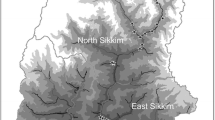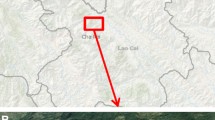Abstract
Mountain ecosystems are relatively more vulnerable to climate change since human induced climate change is projected to be higher at high altitudes and latitudes. Climate change induced effects related to glacial response and water hazards have been documented in the Himalayas in recent years, yet studies regarding species’ response to climate change are largely lacking from the mountains and Himalayas of Nepal. Changes in distribution and latitudinal/altitudinal range shift, which are primary adaptive responses to climate change in many species, are largely unknown due to unavailability of adequate data from the past. In this study, we explored the elevational distribution of butterflies in Langtang Village Development Committee (VDC) of Langtang National park; a park located in the high altitudes of Nepal. We found a decreasing species richness pattern along the elevational gradient considered here. Interestingly, elevation did not appear to have a significant effect on the altitudinal distribution of butterflies at family level. Also, distribution of butterflies in the area was independent of habitat type, at family level. Besides, we employed indicator group analysis (at family level) and noticed that butterfly families Papilionidae, Riodinidae, and Nymphalidae are significantly associated to high, medium and low elevational zone making them indicator butterfly family for those elevational zones, respectively. We expect that this study could serve as a baseline information for future studies regarding climate change effects and range shifts and provide avenues for further exploration of butterflies in the high altitudes of Nepal.
Similar content being viewed by others
References
Acharya BK, Vijayan L (2015) Butterfly diversity along the elevation gradient of Eastern Himalaya, India. Ecological Research 30: 909–919. DOI: 10.1007/s11284-015-1292-0
Bhattarai KR, Upadhyay TP (2015) Rhododendron species richness patterns and impacts of global warming on its distribution in Central Himalayas, Nepal. Botanica Orientalis–Journal of Plant Science 9: 12–19. DOI:10.1046/j.0305-0270.2003.01013.x
Bhattarai KR, Vetaas OR, Grytnes JA (2004) Fern species richness along a central Himalayan elevational gradient, Nepal. Journal of Biogeography 31: 389–400.
Bhuju UR, Shakya PR, et al. (2007) Nepal Biodiversity Resource Book: Protected Areas, Ramsar Sites, and World Heritage Sites. International Centre for Integrated Mountain Development, Ministry of Environment, Science and Technology, in cooperation with United Nations Environment Programme, Regional Office for Asia and the Pacific. Kathmandu, ISBN 978-92-9115-033-5
Bryant SR, Thomas CD, Bale JS (2002) The influence of thermal ecology on the distribution of three nymphalid butterflies. Journal of Applied Ecology 39: 43–55. DOI: 10.1046/j.1365-2664.2002.00688.x
Central Bureau of statistics, Nepal (CBS, 2010) (http://www.cbs.gov.np/, accessed on 2016-10-05)
Chown SL, le Roux PC, Ramaswiela T, et al (2013) Climate change and elevational diversity capacity: do weedy species take up the slack? Biology Letters 9(1): 20120806. DOI:10.1098/rsbl.2012.0806
Devictor V, Van Swaay C, Brereton T, et al. (2012) Differences in the climatic debts of birds and butterflies at a continental scale. Nature Climate Change 2: 121–124. DOI: 10.1038/NCLIMATE 1347
De Cáceres, M. & Legendre, P. (2009) Associations between species and groups of sites: Indices and statistical inference. Ecology 90: 3566–3574
Intergovernmental Panel on Climate Change (IPCC), 1996. Climate Change 1995: The Science of Climate Change. Contribution of Working Group I to the Second Assessment Report of the IPCC. Cambridge University Press, New York.
Hughes L (2000) Biological consequences of global warming: is the signal already apparent? Trends Ecology & Evolution 15: 56–61. DOI: 10.1016/S0169-5347(99)01764-4
Jones JI, Li W, Maberly SC (2003) Area, altitude and aquatic plant diversity. Ecography 26: 411–420. DOI:10.1034/j.1600-0587.2003.03554.x
Khanal B, Chalise M, Solanki G (2012) Diversity of butterflies with respect to altitudinal rise at various pockets of the Langtang National Park, central Nepal. International Multidisciplinary Research Journal 2: 41–48
Konvicka M, Maradova M, Benes J, et al. (2003) Uphill shifts in distribution of butterflies in the Czech Republic: effects of changing climate detected on a regional scale. Global Ecology and Biogeography 12: 403–410.
Leingärtner A, Krauss J, Steffan-Dewenter I (2014) Species richness and trait composition of butterfly assemblages change along an altitudinal gradient. Oecologia 175: 613–623. DOI 10.1007/s00442-014-2917-7
Lomolino MV (2000) Ecology’s most general, yet protean pattern: the species–area relationship. Journal of Biogeography 27: 17–26. DOI:10.1046/j.1365-2699.2000.00377.x
McCain CM (2009) Global analysis of bird elevational diversity. Global Ecology and Biogeography 18: 346–360. DOI: 10.1111/j.1466-8238.2008.00443.x
Palmer G, Hill JK, Brereton TM, et al. (2015) Individualistic sensitivities and exposure to climate change explain variation in species’ distribution and abundance changes. Science Advances 1: e1400220. DOI 10.1126/sciadv.1400220
Pandey R, Khadka KK, Papes M (2015) Geographic and taxonomic biases in conservation research efforts in Nepal. Asian Journal of Conservation Biology 4: 89–91.
Pardikes NA, Shapiro AM, Dyer LA, et al. (2015) Global weather and local butterflies: variable responses to a large-scale climate pattern along an elevational gradient. Ecology 96: 2891–2901. DOI: 10.1890/15-0661.1.sm
Parmesan C, Ryrholm N, Stefanescu C, et al. (1999) Poleward shifts in geographical ranges of butterfly species associated with regional warming. Nature 399: 579–583. DOI:10.1038/21181
Parmesan C (2007) Influences of species, latitudes and methodologies on estimates of phenological response to global warming. Global Change Biology 13: 1860–1872. DOI: 10.1111/j.1365-2486.2007.01404.x
Parmesan C, Yohe G (2003) A globally coherent fingerprint of climate change impacts across natural systems. Nature 421: 37–42. DOI: 10.1038/nature01286
Pollard E (1977) A method for assessing changes in the abundance of butterflies. Biological Conservation 12: 115–134. DOI: 10.1016/0006-3207(77)90065-9
Pollard E (1979) Population ecology and change in range of the White Admiral butterfly Ladoga camilla L. in England. Ecological Entomology 4: 61–74. DOI: 10.1111/j.1365-2311.1979.tb00561.x
Pounds JA, Fogden MP, Campbell JH (1999) Biological response to climate change on a tropical mountain. Nature 398: 611–615. DOI: 10.1038/19297
R Core Team (2016) R: A language and environment for statistical computing. R Foundation for Statistical Computing, Vienna, Austria. URL https://www.R-project.org/
Roy D, Sparks T (2000) Phenology of British butterflies and climate change. Global Change Biology 6: 407–416. DOI: 10. 1046/j.1365-2486.2000.00322.x
Roy DB, Rothery P, Moss D, et al. (2001) Butterfly numbers and weather: predicting historical trends in abundance and the future effects of climate change. Journal of Animal Ecology 70: 201–217. DOI: 10.1111/j.1365-2656.2001. 00480.x
Shrestha AB, Wake CP, Mayewski PA, et al. (1999) Maximum temperature trends in the Himalaya and its vicinity: An analysis based on temperature records from Nepal for the period 1971-94. Journal of climate 12: 2775–2786. DOI: 10.1175/1520-0442(1999)012<2775:MTTITH>2.0.CO;2
Shrestha UB, Gautam S, Bawa KS (2012) Widespread climate change in the Himalayas and associated changes in local ecosystems. PLoS One 7: e36741. DOI: 10.1371/journal.pone. 0036741
Smetacek P (2011) On the Anomalous Altitudinal Distribution of West Himalayan Troidini and Papilionini (Papilionidae). Journal of the Lepidopterists’ Society 65: 126–132. DOI: 10.18473/lepi.v65i2.a5
Smith C (2011) Illustrated Checklist of Nepal’s Butterflies. Department of Biological and Environmental Sciences, Kathmandu University, Nepal.
Telwala Y, Brook BW, Manish K, Pandit MK (2013) Climateinduced elevational range shifts and increase in plant species richness in a Himalayan biodiversity epicentre. PLoS One 8: e57103. DOI: 10.1371/journal.pone.0057103
Thomas CD, Cameron A, Green RE. et al. (2004) Extinction risk from climate change. Nature 427: 145–147. DOI: 10.1038/nature02121
Tulloch AIT, Possingham HP, Joseph LN, et al. (2013) Realising the full potential of citizen science monitoring programs. Biological Conservation 165: 128–138. DOI: 10.1016/j.biocon.2013.05.025
Wilson RJ, Gutierrez D, Gutierrez J, et al. (2007) An elevational shift in butterfly species richness and composition accompanying recent climate change. Global Change Biology 13: 1873–1887. DOI: 10.1111/j.1365-2486.2007.01418.x
Xu J, Grumbine RE, Shrestha A, et al. (2009) The melting Himalayas: cascading effects of climate change on water, biodiversity, and livelihoods. Conservation Biology 23: 520–530. DOI: 10.1111/j.1523-1739.2009.01237.x
Zografou K, Kati V, Grill A, et al. (2014) Signals of climate change in butterfly communities in a Mediterranean protected area. PLoS One 9, e87245. DOI: 10.1371/journal.pone.0087245
Acknowledgments
This study was funded by The Rufford Foundation (http://www.rufford.org/). We would like to thank Dr. Monica Papeş (graduate supervisor of the first author) for her constructive guidance during the proposal development. Also, we thank all the referees and the reviewers
Author information
Authors and Affiliations
Corresponding author
Additional information
http://orcid.org/0000-0001-7130-0201
http://orcid.org/0000-0002-0632-7245
http://orcid.org/0000-0002-5128-108X
http://orcid.org/0000-0002-7920-0106
http://orcid.org/0000-0002-9135-4212
Rights and permissions
About this article
Cite this article
Pandey, R., Khadka, K.K., Ghimire, A. et al. Elevational distribution of butterflies in the Himalayas: a case study from Langtang National Park, Nepal. J. Mt. Sci. 14, 1384–1390 (2017). https://doi.org/10.1007/s11629-017-4360-9
Received:
Revised:
Accepted:
Published:
Issue Date:
DOI: https://doi.org/10.1007/s11629-017-4360-9




